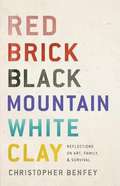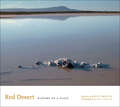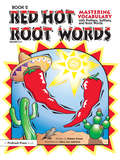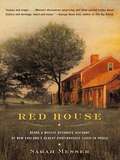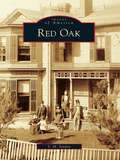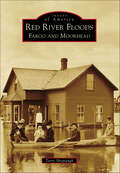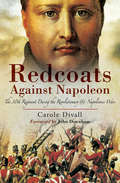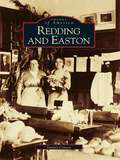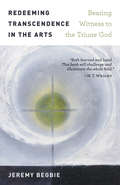- Table View
- List View
Red Brick, Black Mountain, White Clay: Reflections on Art, Family, and Survival
by Christopher Benfey"Beautiful, haunted, evocative and so open to where memory takes you. I kept thinking that this is the book that I have waited for: where objects, and poetry intertwine. Just wonderful and completely sui generis. " (Edmund de Waal, author of The Hare with Amber Eyes) An unforgettable voyage across the reaches of America and the depths of memory, this generational memoir of one incredible family reveals America’s unique craft tradition. In Red Brick, Black Mountain, White Clay, renowned critic Christopher Benfey shares stories—of his mother’s upbringing in rural North Carolina among centuries-old folk potteries; of his father’s escape from Nazi Europe; of his great-aunt and -uncle Josef and Anni Albers, famed Bauhaus artists exiled at Black Mountain College—unearthing an ancestry, and an aesthetic, that is quintessentially American. With the grace of a novelist and the eye of a historian, Benfey threads these stories together into a radiant and mesmerizing harmony. .
Red Carpet: Hollywood, China, and the Global Battle for Cultural Supremacy
by Erich Schwartzel"This is a fascinating book. It will educate you. Schwartzel has done some extraordinary reporting." — The New York Times Book Review &“In this highly entertaining but deeply disturbing book, Erich Schwartzel demonstrates the extent of our cultural thrall to China. His depiction of the craven characters, American and Chinese, who have enabled this situation represents a significant feat of investigative journalism. His narrative is about not merely the movie business, but the new world order.&” —Andrew Solomon, author of Far from the Tree and The Noonday DemonAn eye-opening and deeply reported narrative that details the surprising role of the movie business in the high-stakes contest between the U.S. and ChinaFrom trade to technology to military might, competition between the United States and China dominates the foreign policy landscape. But this battle for global influence is also playing out in a strange and unexpected arena: the movies. The film industry, Wall Street Journal reporter Erich Schwartzel explains, is the latest battleground in the tense and complex rivalry between these two world powers. In recent decades, as China has grown into a giant of the international economy, it has become a crucial source of revenue for the American film industry. Hollywood studios are now bending over backward to make movies that will appeal to China&’s citizens—and gain approval from severe Communist Party censors. At the same time, and with America&’s unwitting help, China has built its own film industry into an essential arm of its plan to export its national agenda to the rest of the world. The competition between these two movie businesses is a Cold War for this century, a clash that determines whether democratic or authoritarian values will be broadcast most powerfully around the world. Red Carpet is packed with memorable characters who have—knowingly or otherwise—played key roles in this tangled industry web: not only A-list stars like Matt Damon, Angelina Jolie, and Richard Gere but also eccentric Chinese billionaires, zany expatriate filmmakers, and starlets who disappear from public life without explanation or trace. Schwartzel combines original reporting, political history, and show-biz intrigue in an exhilarating tour of global entertainment, from propaganda film sets in Beijing to the boardrooms of Hollywood studios to the living rooms in Kenya where families decide whether to watch an American or Chinese movie. Alarming, occasionally absurd, and wildly entertaining, Red Carpet will not only alter the way we watch movies but also offer essential new perspective on the power struggle of this century.
Red Desert: History of a Place
by Martin StupichA photographic and multidisciplinary study of one of America&’s last undeveloped—and most endangered—landscapes, edited by a Pulitzer Prize–winning author.A vast expanse of rock formations, sand dunes, and sagebrush in central and southwest Wyoming, the little-known Red Desert is one of the last undeveloped landscapes in the United States, as well as one of the most endangered. It is a last refuge for many species of wildlife. Sitting atop one of North America's largest untapped reservoirs of natural gas, the Red Desert is a magnet for energy producers who are damaging its complex and fragile ecosystem in a headlong race to open a new domestic source of energy and reap the profits.To capture and preserve what makes the Red Desert both valuable and scientifically and historically interesting, writer Annie Proulx and photographer Martin Stupich enlisted a team of scientists and scholars to join them in exploring the Red Desert through many disciplines: geology, hydrology, paleontology, ornithology, zoology, entomology, botany, climatology, anthropology, archaeology, sociology, and history. Their essays reveal many fascinating, often previously unknown facts about the Red Desert—everything from the rich pocket habitats that support an amazing diversity of life to engrossing stories of the transcontinental migrations that began in prehistory and continue today on I-80—which bisects the Red Desert.Complemented by Martin Stupich&’s photo-essay, which portrays both the beauty and the devastation that characterize the region today, Red Desert bears eloquent witness to a unique landscape in its final years as a wild place.
Red Dog/Blue Dog: When Pooches Get Political
by Chuck Sambuchino"Totally worth the Milk-bones I traded for it." -- Bo Obama"So hilarious I peed on the rug." -- Barney BushPolitics Goes to the Dogs Have you ever considered that man's best friend has political leanings just like we do? Red Dog / Blue Dog reveals that some tails wag to the left and others to the right! With 140 full-color photos of opinionated pooches accompanied by clever captions from the dogs themselves, this amusing book will add some much-needed levity to politics -- whatever side of the political spectrum you are on.
Red Hot Root Words: Mastering Vocabulary With Prefixes, Suffixes, and Root Words (Book 1, Grades 3-5)
by Dianne DrazeHelp students improve their mastery of the English language and acquire the keys for understanding thousands of words by studying Greek and Latin word parts (prefixes, root words, and suffixes). This is one of the most complete, usable presentations of vocabulary development using word parts you will find. A knowledge of word parts gives students a head start on decoding words in reading and testing situations. This is the first book in the two-book series. Each of the well-developed lessons in this text includes: one to three word parts along with meanings and sample words, five vocabulary words that use the prefixes or root words, definitions and sample sentences for each of the five words, a practice exercise that lets students apply knowledge of the words and their meanings, and a one-page review worksheet for one or two lessons that presents more unique opportunities to work with the prefixes and root words and to see how they are combined with suffixes. In addition to the student pages, the teacher's information section includes: an extensive listing of the most common prefixes, root words, and suffixes; their meanings and sample words; additional words for each lesson; andlesson ideas to supplement the word being studied.For older students, use Red Hot Root Words, Book 2. Grades 3-5
Red Hot Root Words: Mastering Vocabulary With Prefixes, Suffixes, and Root Words (Book 2, Grades 6-9)
by Dianne DrazeHelp students improve their mastery of the English language and acquire the keys for understanding thousands of words by studying Greek and Latin prefixes, root words, and suffixes. This is one of the most complete, usable presentations of vocabulary development using word parts you will find. A knowledge of word parts gives students a head start on decoding words in reading and testing situations. This book, the second in a two-book series, contains three sections (prefixes, root words, and suffixes), but each section has the same format. Each of the lessons include: two to four prefixes, suffixes, or root words along with meanings and sample words; 10 new vocabulary words that use these word parts; definitions and sample sentences for each new word; and a one-page worksheet that presents a variety of ways to apply knowledge and expand understanding of the definitions and uses of the word parts. In addition to the extensive student section, this book includes considerable reference material to help the instructor. This includes: a comprehensive listing of prefixes, root words, and suffixes; their meanings and sample words; extra words to use with each lesson; open-ended worksheets that can be used with any lesson; and additional lesson ideas to supplement your word study. For younger students, use Red Hot Root Words, Book 1. Grades 6-9
Red House
by Sarah MesserIn her critically acclaimed, ingenious memoir, Sarah Messer explores America’s fascination with history, family, and Great Houses. Her Massachusetts childhood home had sheltered the Hatch family for 325 years when her parents bought it in 1965. The will of the house’s original owner, Walter Hatch—which stipulated Red House was to be passed down, "never to be sold or mortgaged from my children and grandchildren forever"—still hung in the living room. In Red House, Messer explores the strange and enriching consequences of growing up with another family’s birthright. Answering the riddle of when shelter becomes first a home and then an identity, Messer has created a classic exploration of heritage, community, and the role architecture plays in our national identity. .
Red Lines: Political Cartoons and the Struggle against Censorship (Information Policy)
by Cherian George Sonny LiewA lively graphic narrative reports on censorship of political cartoons around the world, featuring interviews with censored cartoonists from Pittsburgh to Beijing.Why do the powerful feel so threatened by political cartoons? Cartoons don't tell secrets or move markets. Yet, as Cherian George and Sonny Liew show us in Red Lines, cartoonists have been harassed, trolled, sued, fired, jailed, attacked, and assassinated for their insolence. The robustness of political cartooning--one of the most elemental forms of political speech--says something about the health of democracy. In a lively graphic narrative--illustrated by Liew, himself a prize-winning cartoonist--Red Lines crisscrosses the globe to feel the pulse of a vocation under attack.A Syrian cartoonist insults the president and has his hands broken by goons. An Indian cartoonist stands up to misogyny and receives rape threats. An Israeli artist finds his antiracist works censored by social media algorithms. And the New York Times, caught in the crossfire of the culture wars, decides to stop publishing editorial cartoons completely. Red Lines studies thin-skinned tyrants, the invisible hand of market censorship, and demands in the name of social justice to rein in the right to offend. It includes interviews with more than sixty cartoonists and insights from art historians, legal scholars, and political scientists--all presented in graphic form. This engaging account makes it clear that cartoon censorship doesn't just matter to cartoonists and their fans. When the red lines are misapplied, all citizens are potential victims.
Red Lipstick: An Ode to a Beauty Icon
by Rachel FelderA unique, full-color compendium that celebrates and explores the enduring power and allure of the world’s most iconic lip shade, jam-packed with entertaining stories, anecdotes, little-known facts, quotes, and more than 100 gorgeous images culled from fine art, photography, and beauty and fashion editorial and advertising.“Pour yourself a drink, put on some lipstick, and pull yourself together.” — Elizabeth TaylorLipstick is the one makeup item most women can’t live without—and the most iconic shade is red. Exuding power, sensuality, allure, and mystery, red lips have been a constant of fashion for more than 5,000 years, beginning with Mesopotamian women around 3500 B.C. Throughout the ages, red lipstick has been a signature look worn by royalty, celebrities, and real women across cultures and geography. In fact, nearly all women own a tube of red lipstick, whether it’s the favorite shade they’ve been wearing devotedly for years, or as beauty boost they use for special occasions.Filled with a show-stopping selection of images and distinctively packaged—the size of a clutch, with a jacket printed with a matte, velvet, red finish—Red Lipstick is the only cultural history of this makeup essential available. Granted unprecedented access to experts and the archives of revered brands like Chanel and Elizabeth Arden, beauty writer Rachel Felder explores the origins and allure of red lipstick and illuminates its association with aristocracy, sex appeal, illicit sexuality, rebellion, power, glamour, fame, and beauty. She also spotlights the fascinating array of women who have worn it through the ages, including monarchs, suffragettes, flappers, working women in World War II, first ladies, political leaders, geishas, Hollywood sirens, rock and rollers, fashionistas, and more. Inside this enthralling book, you’ll discover why red lipstick makes women more attractive to others (and the science behind it); tips on choosing the most perfect shade of crimson; and a wealth of anecdotes, quotations, select literary excerpts, and trivia, such as the shade Carolyn Bessette Kennedy wore on her wedding day. Red Lipstick is packed with a museum’s worth of fine art, including both Man Ray’s photograph “Red Badge of Courage” and infamous painting “Les Amoreaux;” lush, rarely seen vintage magazine advertisements from stalwart brands like Guerlain and Dior; illustrations by renowned fashion illustrators such as René Gruau, Daisy Villeneuve, and Bil Donovan; artists Dante Gabriel Rossetti, Edgar Degas, Ernst Ludwig Kirchner, Wayne Thiebaud, and Walt Kuhn; and images of famous red lipstick wearers including Cleopatra, Queen Elizabeth II, Coco Chanel, Grace Kelly, Marilyn Monroe, Audrey Hepburn, Madonna, Diana Vreeland, Rihanna, Paloma Picasso, and many others. With its captivating, chic design, beautiful selection of visuals, and engaging, entertaining text, Red Lipstick is a classic, like the perfect red lip shade itself.
Red Oak (Images of America)
by S. M. SendenWhere the Red Oak Creek flowed into the Nishnabotna River, thick groves of walnut, oak, and cottonwood trees crowded about their banks. This gentle intersection of waterways was to become the junction of railroads, highways, and so many people's lives. The seeds of the hopes and dreams of early pioneers where planted in the fertile soil. Nurtured by the promise of the railroad, the town began to grow and earned the honor of becoming the county seat. With the building of the railroad, Red Oak Junction was regarded second only to Deadwood as a wild outpost on the western frontier. With the completion of the railroad, the laborers left, taking that reputation with them, and Red Oak blossomed into a booming city directed by the strong personalities of the city fathers who sought to have it be a leader of culture, building, technological improvements, and businesses in the state. Fires, grasshoppers, hailstorms, and floods could not dampen the indomitable spirit of those who have lived in Red Oak through the years.
Red River Floods: Fargo and Moorhead (Images of America)
by Terry ShoptaughFargo, North Dakota, and Moorhead, Minnesota, have existed on opposite sides of the Red River of the North since 1871. Ever since, heavy moisture from melting snow has combined with spring rains to threaten both towns with a rapidly rising, twisting river. Minor flooding is almost an annual event, and on six occasions the two towns experienced major floods requiring evacuations of large numbers of residents. The history of these floods is covered in the photographs contained in this book, including many provided by residents, local flood-fighting crews, and state and federal agencies. These images tell the story of how the two communities deal with one of nature's most common dangers.
Red Sox Legends (Images of Baseball)
by Boston Red Sox Jennifer Latchford Boston Public Library Rod OresteThrough a combination of player interviews and historical narrative, Red Sox Legends is a tribute to the great players of the past. This book, a partnership between the Boston Public Library and the Boston Red Sox, is part of an effort to bring Red Sox history to life. Large format prints of most of the images included here are hung inside Fenway Park. The images shown are a sampling of the over 750,000 photographs in the library's collection and the tens of thousands of images in the Red Sox archives.
Red Star Over Hollywood: The Film Colony's Long Romance with the Left
by Ronald Radosh Allis RadoshUntil now, Hollywood's political history has been dominated by a steady stream of films and memoirs decrying the "nightmare" of the Red Scare and how it victimized political innocents. But in Red Star over Hollywood, Ronald and Allis Radosh tell for the first time the "backstory" behind this myth. The authors show how the Soviet Comintern decided to make the film capital a prime target in the late 1920s. They follow the lives of Budd Schulberg, Ring Lardner Jr., Maurice Rapf and other young radicals who journeyed to the USSR in the early 1930s, underwent a political conversion experience there, and came back to Hollywood as apostles preaching a Soviet gospel. They take us inside the cells and discussion groups that Communist Party members formed, the guilds and unions they tried to take over, and the studios they aimed to influence. The Radoshes not only prove that the members of the Hollywood Party were loyal first and foremost to Joseph Stalin, but demonstrate that in fact many of the screenwriters who later became part of the Hollywood Ten succeeded in using film as a propaganda medium in behalf of the Soviet cause. One of their most significant accomplishments was the wartime blockbuster Mission to Moscow, whose inside story the authors document in fascinating detail. The Radoshes are at their best when writing about the blacklist era. They take us inside the strategy sessions of the Hollywood Communists as they prepared to testify in front of the House Committee on Un-American Activities, revealing that while others were lionizing them as blameless victims of American nativism and paranoia, the Hollywood Reds themselves were beset by doubts and disagreements about their disloyalty to America and their treatment by the Communist Party. Creating memorable portraits of Dalton Trumbo, Elia Kazan and John Garfield, the authors also trace the afterlives of those touched by HUAC and the blacklist, and document their continuing argument with America and each other through the next half-century. Red Star over Hollywood is an epic work about one of the most discussed but least understood episodes in our political life. Getting behind the denial and apologetics, the Radoshes tell a story whose long half-life has not ended. The men and women who agitated for Communism decades ago created a living legacy used by Jane Fonda and others who revived the Hollywood Left in the 1960s, and by figures such as Susan Sarandon, Tim Robbins and Sean Penn in the equally turbulent filmland politics of today. Ronald Radosh, adjunct Senior Fellow at the Hudson Institute, was the first writer to establish the guilt of Julius Rosenberg, in his bestselling book, The Rosenberg File. He is also the author of Commies: A Journey Through The Old Left, The New Left, and the Leftover Left. Allis Radosh is the author of Persia Campbell: Portrait of a Consumer Activist.
Red Ted Art: Cute and Easy Crafts for Kids
by Margarita WoodleyCrafting has never been more popular and Maggy Woodley, the creative force behind Red Ted, is passionate about making things with her children, Max, four, and Pippa, two. Using recycled materials and bits and bobs collected when out and about, here are over 60 utterly irresistible things to make with your kids. From adorable peanut shell finger puppets to walnut babies, loo roll marionettes and egg carton fairy lights, fabric mache bowls, stick men and shell crabs, stone people, and many more, these are projects for all the family to have fun with. And what's more, the end results are so cute and desirable that they look great around the home, or make wonderfully unique and personal gifts.With a funky, modern design and vibrant full colour photography throughout, this is a must-have addition to every young family's bookshelf.
Red vs. Blue Apple FF: The Ultimate Fan Guide
by Rooster Teeth Eddy Rivas Burnie BurnsIn Red vs. Blue, its creators at Rooster Teeth brings together more than a decades' worth of ephemera and behind-the-scenes information from the popular comedic web series, including:Character dossiers and fact sheetsCharacter-driven lists, including "The Wisdom of Caboose"Charts and statistics mapping out character, world, and episode triviaBest Red vs. Blue quotes. Of all timeAlternate stories and character arcs that were abandonedSpotlights on the cast and crew of Red vs. Blue, filled with unique anecdotes, behind-the-scenes stories, and insights into the series and their roleNew, never-before-seen content: Includes annotated scripts of some of the most-watching episodes, side-stores, expanded universe material, alternate endings, deleted scenes and triviaOriginal sketches and drawings
Red, White & Black: Cinema and the Structure of U.S. Antagonisms
by Frank B. Wilderson IIIRed, White & Black is a provocative critique of socially engaged films and related critical discourse. Offering an unflinching account of race and representation, Frank B. Wilderson III asks whether such films accurately represent the structure of U. S. racial antagonisms. That structure, he argues, is based on three essential subject positions: that of the White (the "settler," "master," and "human"), the Red (the "savage" and "half-human"), and the Black (the "slave" and "non-human"). Wilderson contends that for Blacks, slavery is ontological, an inseparable element of their being. From the beginning of the European slave trade until now, Blacks have had symbolic value as fungible flesh, as the non-human (or anti-human) against which Whites have defined themselves as human. Just as slavery is the existential basis of the Black subject position, genocide is essential to the ontology of the Indian. Both positions are foundational to the existence of (White) humanity. Wilderson provides detailed readings of two films by Black directors, Antwone Fisher (Denzel Washington) and Bush Mama (Haile Gerima); one by an Indian director, Skins (Chris Eyre); and one by a White director, Monster's Ball (Marc Foster). These films present Red and Black people beleaguered by problems such as homelessness and the repercussions of incarceration. They portray social turmoil in terms of conflict, as problems that can be solved (at least theoretically, if not in the given narratives). Wilderson maintains that at the narrative level, they fail to recognize that the turmoil is based not in conflict, but in fundamentally irreconcilable racial antagonisms. Yet, as he explains, those antagonisms are unintentionally disclosed in the films' non-narrative strategies, in decisions regarding matters such as lighting, camera angles, and sound.
Red, White & Blue Star Quilts: 16 Striking Patriotic & 2-Color Patterns
by Judy MartinQuilt Americana: Patriotic star quilts from Judy Martin Pay tribute to The Stars and Stripes with patriotic quilts in red, white, and blue! Fans of Judy Martin’s popular (and now out-of-print) Shakespeare in the Park pattern will delight in 16 quilt designs to honor the Land of the Free. You’ll piece 2- and 3-color star quilts that incorporate classic blocks, like the Rising and Evening stars. Whether you prefer small and simple throws or beautiful bed quilts, this cohesive collection has something for everyone. Honor Old Glory with 16 exciting star quilts in red, white, and blue Esteemed designer Judy Martin shares all-new quilts plus out-of-print favorites Create a bold collection of 2- and 3-color beauties for all skill levels
Red, Yellow, Blue (and a Dash of White, Too!)
by Charles George EsperanzaSplish! Splash! Sploosh! A little girl is about to discover the wonders of mixing colors. With the sound of paint splatter, a bright blue elephant named EleBooyah enters the scene. She wants to help paint, too, and pretty soon the girl and her elephant are playing with all the colors of the rainbow. What do blue and yellow make? A funky green frog! And red and blue? An enormous purple octopus king! What other creatures are waiting for the splatter of paint on a brush to join the raucous painting party?Charles George Esperanza’s author/illustrator debut is a riot of color and magic. Esperanza's rhythmic stanzas and vibrant illustrations tickle the imagination, and this is sure to become a staple color book for kids across the country.Sky Pony Press, with our Good Books, Racehorse and Arcade imprints, is proud to publish a broad range of books for young readers-picture books for small children, chapter books, books for middle grade readers, and novels for young adults. Our list includes bestsellers for children who love to play Minecraft; stories told with LEGO bricks; books that teach lessons about tolerance, patience, and the environment, and much more. While not every title we publish becomes a New York Times bestseller or a national bestseller, we are committed to books on subjects that are sometimes overlooked and to authors whose work might not otherwise find a home.
Red-Blooded American Male: Photographs
by Robert TrachtenbergA collection of 100 inspired and surprising portraits of celebrities and everymen alike from the award-winning photographer Robert Trachtenberg.Paul Rudd checking out the merchandise; Jimmy Kimmel playing dress up; Jack Black getting a one-of-a-kind pedicure; Elon Musk unveiling his newest Tesla; Jerry Seinfeld and Larry David taking a coffee break.From leading men to comedians, ballet dancers to quarterbacks, war veterans to Broadway veterans, Red-Blooded American Male features more than 100 imaginative, striking, and sexy portraits from award-winning photographer Robert Trachtenberg. Pithy captions about each shoot accompany the photographs, giving readers a peek behind the curtain of a famed portrait photographer's creative process and his world-renowned photographs.Uncovering a unique (and often self-deprecating) side to such talents as Jimmy Fallon, Seth Rogen, Channing Tatum, Waris Ahluwalia, Will Ferrell, and Kevin Hart, this collection goes beyond mere portraiture to challenge conventional notions of masculinity and traditional male imagery.
Red: The History of a Color
by Michel PastoureauA beautifully illustrated visual and cultural history of the color red throughout the agesThe color red has represented many things, from the life force and the divine to love, lust, and anger. Up through the Middle Ages, red held a place of privilege in the Western world. For many cultures, red was not just one color of many but rather the only color worthy enough to be used for social purposes. In some languages, the word for red was the same as the word for color. The first color developed for painting and dying, red became associated in antiquity with war, wealth, and power. In the medieval period, red held both religious significance, as the color of the blood of Christ and the fires of Hell, and secular meaning, as a symbol of love, glory, and beauty. Yet during the Protestant Reformation, red began to decline in status. Viewed as indecent and immoral and linked to luxury and the excesses of the Catholic Church, red fell out of favor. After the French Revolution, red gained new respect as the color of progressive movements and radical left-wing politics.In this beautifully illustrated book, Michel Pastoureau, the acclaimed author of Blue, Black, and Green, now masterfully navigates centuries of symbolism and complex meanings to present the fascinating and sometimes controversial history of the color red. Pastoureau illuminates red's evolution through a diverse selection of captivating images, including the cave paintings of Lascaux, the works of Renaissance masters, and the modern paintings and stained glass of Mark Rothko and Josef Albers.
Redcoats Against Napoleon: The 30th Regiment During the Revolutionary and Napoleonic Wars
by Carole DivallMilitary histories of the struggle against the French armies of the Revolution and Napoleon often focus on the exploits of elite units and famous individuals, ignoring the essential contribution made by the ordinary soldiers the bulk of the British army. Carole Divall, in this graphic and painstakingly researched account, tells the story of one such hitherto ignored group of fighting men, the 30th Regiment of the Line. She takes their story from one of the opening clashes of the long war, the Siege of Toulon in 1793, to the decisive Battle of Waterloo in 1815. She gives us a fresh perspective on key events the men took part in Massenas retreat from the Lines of Torres Vedras, the bloody storming of Badajoz, the retreat from Burgos, the ordeal of the troops holding the centre of Wellingtons Waterloo position. The regiments history which she describes using some hitherto unpublished and vivid memoirs left by the men themselves and those they fought alongside offers a fascinating insight into the life of British soldiers two centuries ago.
Redding and Easton
by Daniel CrusonThis spectacular photographic history traces the paralleldevelopment of two two contiguous towns in southernConnecticut: Redding and Easton. Both towns were originally part of the Colonial town of Fairfield and developed as marginal farming communities. Both towns experienced an incipient industrial revolution, which never matured, and both later became retreats for summer visitors and prominent literary figures. In the years after World War II, the two towns evolved into suburban communities. Today, they share not only a common history but also a regional high school. Redding and Easton highlights each period in the development of the two towns. The book emphasizes Georgetown, which continued to be an industrial enclave long after other industry in the town died out. It devotes a chapter to literary figures, such as Mark Twain, Edna Ferber, and Ida Tarbell, who migrated to these rural towns at the end of the nineteenth century and gave them the image of a rural literary retreat. Redding and Easton recognizes the prominent citizens who created a summer colony that attracted the rich and famous from all over the Northeast. The book also stresses the everyday events and special occasions that marked the nature of these towns in the twentieth century.
Redeeming Art: Critical Reveries
by Donald KuspitIn essays culled from three decades of critical writing, Donald Kuspit explores the aesthetic developments of the twentieth century, from post-impressionism to the latest permutation of post-Modernism. Ranging from Willem de Kooning to Andy Warhol to Sue Coe, this provocative anthology chronicles the distinctive voice of a formidable art critic whose reflections on art, artists, and art criticism constitute an eclectic exploration of the ways in which art and art criticism have influenced contemporary thought and psychology. The book's investigation into the social impact of artwork also reflects on the inner life of the artist.
Redeeming Transcendence in the Arts: Bearing Witness to the Triune God
by Jeremy BegbieHow can the arts witness to the transcendence of the Christian God? Many people believe that there is something transcendent about the arts, that they can awaken a profound sense of awe, wonder, and mystery, of something &“beyond&” this world—even for those who may have no use for conventional forms of Christianity. In this book Jeremy Begbie—a leading voice on theology and the arts—employs a biblical, Trinitarian imagination to show how Christian involvement in the arts can be shaped by the distinctive vision of God&’s transcendence opened up in and through Jesus Christ.
Redeeming the Dial
by Tona J. HangenBlending cultural, religious, and media history, Tona Hangen offers a richly detailed look into the world of religious radio. She uses recordings, sermons, fan mail, and other sources to tell the stories of the determined broadcasters and devoted listeners who, together, transformed American radio evangelism from an on-air novelty in the 1920s into a profitable and wide-reaching industry by the 1950s.Hangen traces the careers of three of the most successful Protestant radio evangelists--Paul Rader, Aimee Semple McPherson, and Charles Fuller--and examines the strategies they used to bring their messages to listeners across the nation. Initially shut out of network radio and free airtime, both of which were available only to mainstream Protestant and Catholic groups, evangelical broadcasters gained access to the airwaves with paid-time programming. By the mid-twentieth century millions of Americans regularly tuned in to evangelical programming, making it one of the medium's most distinctive and durable genres. The voluntary contributions of these listeners in turn helped bankroll religious radio's remarkable growth. Revealing the entwined development of evangelical religion and modern mass media, Hangen demonstrates that the history of one is incomplete without the history of the other; both are essential to understanding American culture in the twentieth century.
